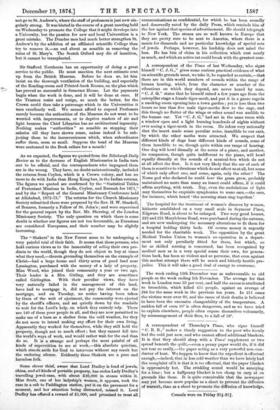A correspondent of the Times of last Wednesday, who signs
himself " C. J. G.," gives some curious practical evidence of what on scientific grounds must, we take it, be regarded as certain,—that there are in this world numbers of sounds within the range of human hearing, which, from the character or number of the vibrations on which they depend, are never heard by man. "C. J. Gr." states that he himself raised a few years ago from the caterpillar stage a female tiger-moth, and put it in a gauze cage in a smoking-room opening into a town garden ; yet in less than two hours no less than five male tiger-moths flew to the cage, and this though no flutter of the wings or other sound was audible to the human ear. Yet "C. J. G," had sat in the same room with a window open and a light burning hundreds of nights without ever seeing a tiger-moth in the room. He infers very rationally that the insect made some peculiar noise, inaudible to our ears, by which the other moths were attracted. We suspect that different kinds of dogs hear different kinds of sounds, some of them inaudible to us, though quite within our range of hearing. One dog will howl dismally at the notes of a piano, and another, its companion, though quite indifferent to the piano, will howl equally dismally at the sounds of a musical-box which do not at all affect the first. Is it not very likely that the ear of each of them is sensitive to vibrations which do not affect us at all, but some of which only affect one, and some, again, only the other? The Norse god who declared he could hear the grass grow, probably maintained no more than many an insect could affirm, if it could affirm anything, with truth. Nay, even the undulations of light may themselves be exquisite symphonies to some ears,—the ears, for instance, which heard 'the morning stars sing together.'






































 Previous page
Previous page